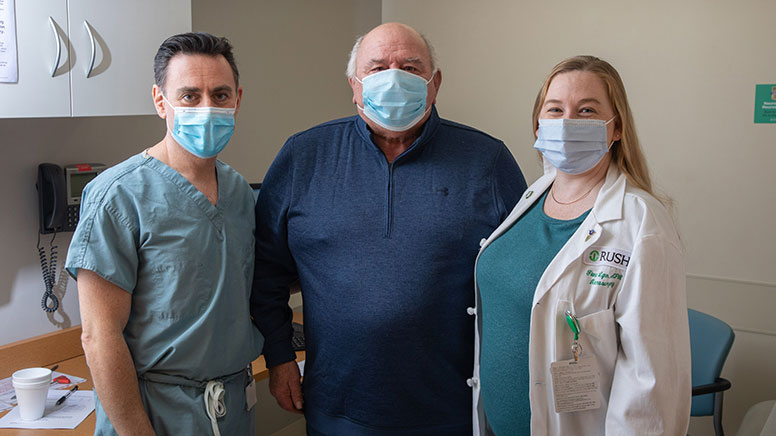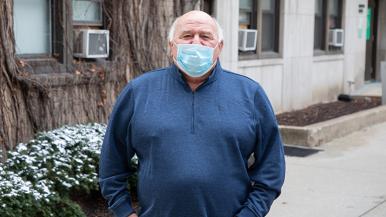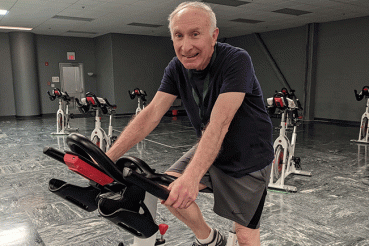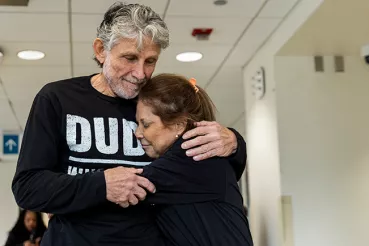About 20 years ago, Rick Kingsnorth noticed a slight, uncontrollable shake in both of his hands and arms when he was 51 years old. Eventually, he was diagnosed with essential tremor, which gradually became worse and began to affect every aspect of his daily life over the years.
“It got to the point where I couldn’t use a fork to eat, and I couldn’t drink or carry a cup without holding it with two hands,” Rick says. “But one of the most frustrating things I eventually couldn’t do was write my name or anything legible — I felt helpless.”
As the tremors progressed, Rick adapted his routines and became more dependent on others. In 2018, he decided it was time to seek help. His doctor prescribed a medication that stopped the tremors for a short period of time. However, Rick was interested in finding more long-term relief, which is what led him to Rush.
Rick made an appointment with the movement disorders team at Rush, where he underwent multiple tests and met with several doctors — including neurosurgeon Sepehr Sani, MD — who evaluated the severity of his tremors and discussed treatment options with him.
“Patients with a longstanding history of tremors usually adapt until it becomes so restrictive that they realize they don't have quality of life left anymore — and Rick was a classic example of this,” Sani says. “At that time, the only technology available for him was deep brain stimulation (DBS), a surgical procedure that can help relieve symptoms from essential tremor.”
Due to his health history and age, Rick was concerned about the risk associated with DBS. Rick continued to follow up with his Rush care team regularly. Last year, his team suggested a new noninvasive option to treat his tremors called MR-guided focused ultrasound.
An opportunity for change
In the beginning of 2020, Rush University Medical Center became the only center in Illinois and surrounding states to offer MR-guided focused ultrasound. The procedure allows neurosurgeons to precisely target the spot in the brain of patients with essential tremors and parkinsonian tremor that causes their tremor — without open surgery — and significantly reduce the severity of tremor.
“Given how severely Rick was affected by essential tremor along with his medical history, MR-focused ultrasound was the safest option,” Sani says. “He was the perfect candidate for it.”
Rick originally scheduled it for March 2020. However, due to the COVID-19 pandemic, his procedure was delayed until the summer.
“I really wanted to get the procedure, and I felt like Rush was taking every precaution — through temperature checks, mask wearing and sanitizing — so I felt confident moving forward with the procedure,” Rick says.
A life-changing procedure
Rick was Rush’s first patient registered for a MR-guided focused ultrasound, and on July 7, 2020, he became the ninth patient to undergo the procedure at Rush.
Currently, the procedure is FDA-approved for unilateral (one side of the body) treatment of tremor. Rick opted to have his doctors treat the side that would affect his dominant hand for writing, or his right hand.
The morning of the procedure, Rick underwent a few basic tests — one of which was to write his name to the best of his ability. This would eventually allow his care team to gauge the effectiveness of the procedure by comparing the before and after tests once the procedure was complete.
During the procedure, Rick was placed in an MRI scanner. His care team was then able to target the area to treat by delivering ultrasound energy, or sound waves, that generated heat and made a tiny lesion in his brain. This approach is proven to significantly improve or eliminate tremors.
After an hour and a half, the procedure was complete — and Rick no longer had a tremor in his right hand.
The first thing my care team had me do after the procedure was write my name again — and the difference compared to my first attempt only hours before was absolutely remarkable.
By noon that same day, Rick was home recovering, and he continues to see his care team at Rush at follow-up appointments to keep track of his progress.
The new Rick
Following the procedure, Rick has enjoyed his newfound movement in his right arm and hand — and maybe a little too much.
“I tried to push it more than I should have,” he says. “Before the tremors, I was quite active, so after the procedure, I was eager to regain that part of my life. But I quickly learned that this is not the way it works, and that it’s more of a process.”
Although Rick has experienced issues with balance, Sani notes that this is a normal and often temporary side effect for the noninvasive procedure.
“Our patients will sometimes see such dramatic improvement in tremors that they tend to translate that into doing more of the things that they couldn’t do before,” Sani says. “They actually need to take it easy during the recovery process.”
Overall, Rick and his care team are satisfied with the results of the procedure, and his decision to move forward with this treatment option.
“Rick is a very resilient individual,” Sani says. “I applaud him for having the courage and diligence to follow through and choose an option to help his quality of life in a way that was acceptable for him. I respect him tremendously for that.”
Thank you to Rush
Rick credits his successful procedure and positive experience to his care team, and hopes others living with essential tremor will consider and take advantage of MR-guided focused ultrasound at Rush.
“Beyond the results, my care team — particularly Dr. Sani, and Fiona Lynn, NP, among others — genuinely cared about me, my health and my family,” he says. “They are down-to-earth people, and I want to thank everyone at Rush for helping to get part of my life back.”

Rick (center) surrounded by his care team (left to right): Sepehr Sani, MD, and Fiona Lynn, NP.




